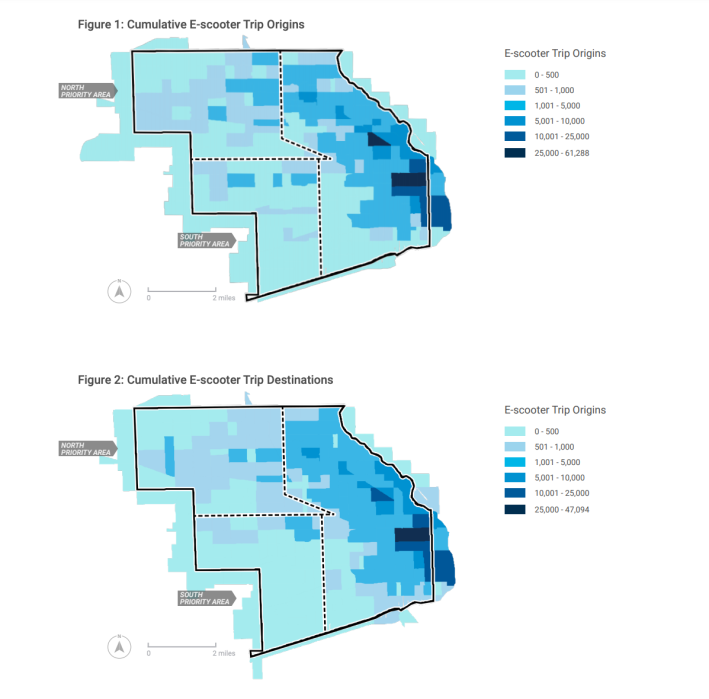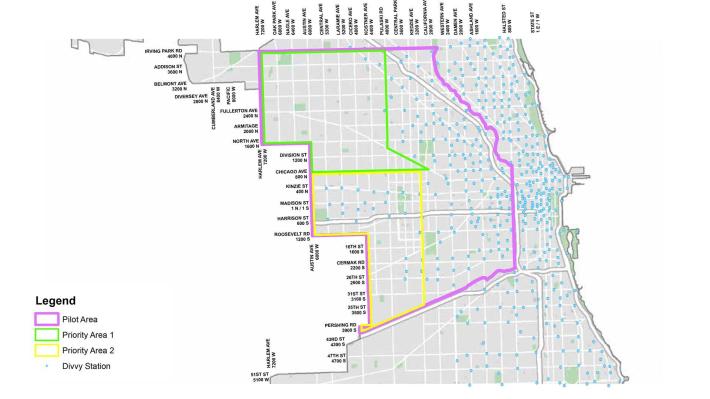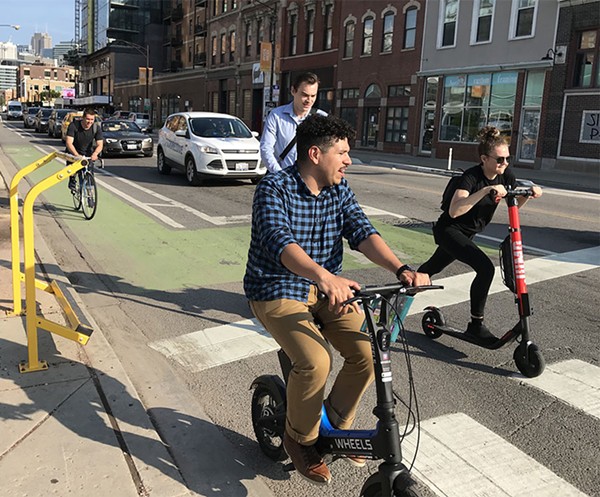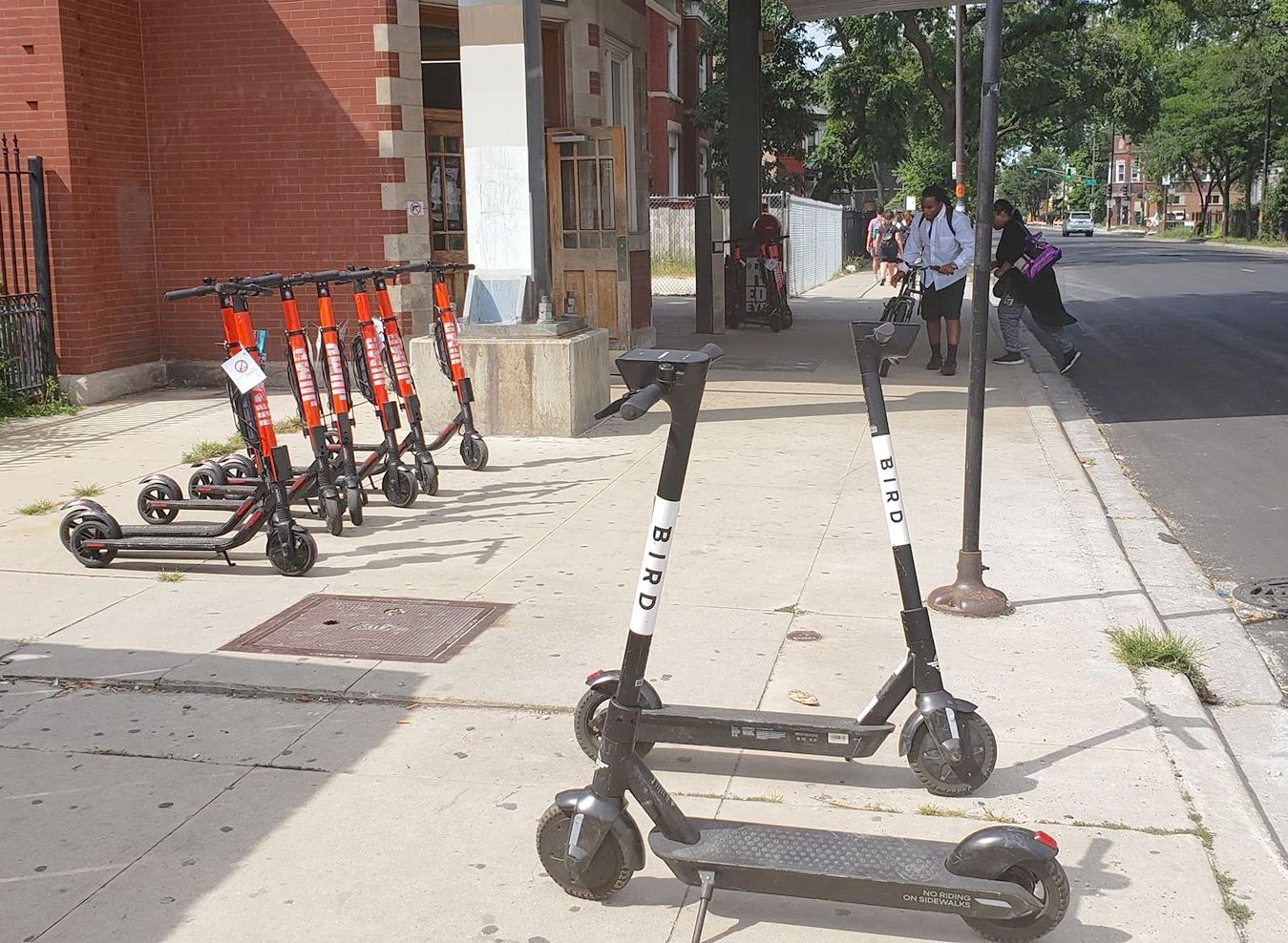Chicagoans who enjoyed riding zippy dockless electric scooters during last year's four-month pilot on the West and Northwest sides, as well as the ten companies that supplied them, may have assumed that once the weather gets warmer this year the city would allow the technology here on a permanent basis. Sorry, but that's not happening.
Today the city released findings from a study of the scooter test, which saw 821,615 rides on 2,500 of the devices (averaging about three rides per vehicle a day), as well as 192 reported scooter-related injuries. The main conclusion of the report is that a second pilot is needed to gather more data, but city officials aren't yet saying what the format of this year's test will be, pending more community input on how the next test should work.
"The first part of the pilot really helped us moving into a second," said Commissioner Gia Biagi from the Chicago Department of Transportation, which oversaw the the program along with the Chicago Department of Business Affairs and Consumer Protection, in an interview yesterday. "We know that we actually have to dig a little deeper. So it was a nice first round, we got a lot of info, and now we can be more precise in the questions that we're asking... At the end of the next pilot we'll have enough info to make a good decision. As my father-in-law, a carpenter, likes to say, 'Measure twice, cut once.'"
The goal of the new study (read it here), conducted by the city with help from the Center for Neighborhood Technology, was to get a sense of how the e-scooters affected communities in the pilot zone, other transportation modes, and public safety. Last year's test ran from June 15 to October 15, and each of the ten companies was allowed to deploy 250 vehicles. In addition to the scores of reported injuries, issues that arose included sidewalk clutter, and vendor non-compliance with rules requiring fair distribution of the devices within the pilot zone, the removal of the vehicles at night, and other regulations.
“While the e-scooter program holds promise, it warrants additional review to determine how we hold vendors accountable, keep Chicagoans safe and improve citywide mobility,” said Mayor Lori Lightfoot in a statement. “While the initial pilot revealed mixed results, my team will continue to bring community members and all stakeholders to the table to identify improved guidelines and gauge if the scooter program is a viable long-term solution."

The report was partly based on a month-long public online survey, with over 12,000 participants. Feedback was also collected via through stakeholder meetings, analysis of complaint data, emails to the scooter feedback email address, and in-person observations of scooter riding and parking.
More findings from the study:
- The scooters were used most frequently during the evening rush on weekdays and between 3 and 4 p.m. on weekends.
- 77 percent of rides started or ended in the transit-rich eastern half of the pilot zone. "This result indicates that more work needs to be done to understand how e-scooters could help supplement transportation in communities with limited access to other modes of transportation," the city said.
- 34 percent of online survey respondents said they used the devices to go to or from transit.
- Ridership dropped significantly during the course of the pilot, with twice as many trips taken during the first week as the last. In addition, many trips were short and started and ended in the same location, which suggests that many users were simply taking joy rides, rather than using the vehicles for transportation.
- 59 percent of respondents said e-scooter companies should be allowed to keep operating in Chicago. However, tellingly, while 84 percent of people who had used the devices felt that way, a mere 21 percent of non-riders wanted to see the program continue.
During yesterday's interview, CDOT's Biagi and BACP commissioner Rosa Escareno had little info about what the 2020 pilot, which will likely start this summer (which will surely annoy folks who were hoping to start riding again in the spring), will look like. They said the timing, location, and scope of the next test will be shaped by upcoming meetings with transportation advocates, people with disabilities, business groups, community organizations and other stakeholders. Trip data will also be made public on the Chicago Data Portal to support third-party independent analysis of the program.
Asked whether the West and Northwest sides will get scooters again, Biagi responded, "We're definitely interested in areas where there's demand and where people are raising their hands. But we also want to make sure that we're continuing to build out on the equitable test that we did in Round 1 and determining the best geography." The Active Transportation Alliance has called for expanding the scooter zone citywide, except for downtown and on muti-use paths, including the Lakefront Trail.

While the report states that there were 192 reported scooter-related injuries during the pilot, or 1.6 injuries per day, it cautions that there are some important limitations to the data since it doesn't include injuries that didn't result in an ER visit, and only includes injuries that were correctly labeled in the medical record. 26 Illinois hospitals, including 18 Chicago hospitals reported 192 probable ED visits due to e-scooter injuries from June 15 to October 15, 2019. Twelve hospitals reported at least five injuries, while Presence Saints May and Elizabeth Medical Center, located in Wicker Park, a popular neighborhood for scooter riding, reported a whopping 61 e-scooter injuries during the test. That's in keeping with the trends Streetsblog Chicago discovered while doing informal surveys of local hospitals.
According to the data there were 23.36 people injured per 100,000 e-scooter trips, which means that one out of every 4,281 rides resulted in an ER visit. Ten pedestrians (about 5 percent of injuries) and one cyclist were among the scooter-related injury cases. In one incident, a child was injured while riding on their parent's back on a scooter.

I asked Biagi whether the city had considered encouraging or mandating scooter designs that may be safer for potholed city streets, such as models with a seated rider position and larger wheels. "We have the opportunity to really push the industry on this kind of question, whether it's wheel size or other things they could do with the tech to make this safer."
The mobility justice nonprofit Equiticity has also endorsed expanding scooter usage citywide, and called on the city to ensure that the future scooter program will have mobility and economic benefits for Black and Latino communities, including job creation. "In the first pilot we worked aggressively with companies, pushing them to actually be in these neighborhoods, not only to test the pilot and intriduce their concepts, but also to talk about the programs they had that were cash-based for people that didn't have [credit cards and/or smartphones]," said BACP's Escareno. According to the new report, none of the ten companies consistently met the city's requirement to distribute 25 percent of their fleet in the two westernmost "priority area" quadrants of the pilot zones, locations with few or no Divvy stations.
As for the complaint that poorly parked scooters were an obstacle to pedestrians and wheelchair users, Biagi said, "We'll continue to have conversations with the disability community who've experienced that." Could the issue be addressed by requiring the vendors to fund on-street scooter parking corrals? "That's something that we'll be looking into very seriously as we move forward."





